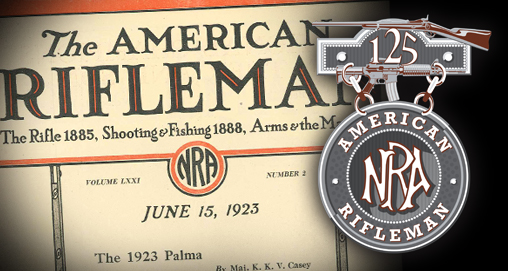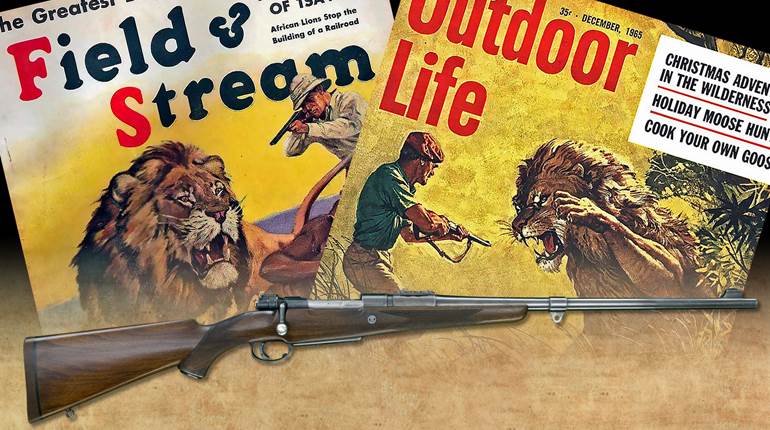
From the January 1991 issue of American Rifleman:
A dozen years after departing his native continent, the author goes afield in Tanzania and Botswana as a hunter.
I had some misgivings when, 12 years after I had left Africa for good, Jack Carter of Trophy Bonded Bullets inquired whether I would be interested in accompanying him on a hunt to Tanzania and Botswana to test some of his latest bullets.
For one thing, instead of being in charge, I would now be merely a visiting dude who would have to let someone else run the show his way. But of course I could not turn it down, especially when I learned that our professional hunters would be Robin Hurt and Tony Henley, both Kenya chaps whom I knew from before.
Carter had newly moved his operation into a larger plant to allow him to dramatically increase both the volume and the variety of his production and had just designed new bullets in .243, .257 and 6.5 mm cals. that he wanted to try.
His original Bear Claw bullets used pure lead cores bonded to machined copper jackets with very thick walls towards the base. Lately, he has taken the concept a step farther with his Solid Shank bullets, which have solid copper bases with only a small, bonded lead core in the forward half of the bullet. The jackets are drawn very thin at the nose, and in addition the copper is selectively work-hardened so as to be soft forward and tougher towards the base. Expansion starts very readily but is controlled and slowed down as it progresses, stopping completely when it reaches the bullet’s solid shank. In muscle and soft tissue the Bear Claw Solid Shank bullets expand to form perfect, advertising-picture “mushrooms” that typically retain 90% of their original weight and give excellent penetration.
When they encounter massive bone, on the other hand, some of the claws of expanded jacket and lead may break off, or else they are folded in tight against the shank so as to present a smaller frontal area that permits the bullet to keep ploughing on. The effect is almost that of two bullets in one: an expanding soft-nose that will chop a very wide wound channel, backed up by a deep-driving, non-expanding solid rear half.
I had my Mauser-actioned switch-barrel rifle in .416 Rem. Mag. (see June 1990, p. 50) with Carter’s 400-gr. Bullets at 2400 f.p.s. and a 6.5x55mm rifle in which I used the new Solid Shank 140-gr. Bullets loaded to give 2580 f.p.s. on the chronograph.
The .416 was fitted with a Leupold Compact 2.5X scope, which I think is an ideal glass for a rifle of this type, while the 6.5 mm bore a Leupold M8-3X, which is unfortunately no longer made. In addition, the .416 carried a Remington adjustable V back sight and a large white bead foresight as an emergency standby system. But I had no intention of using those sights unless the glass went completely haywire, having long since learned that a low-power scope beats iron sights for almost any purpose whatsoever.
On the second to last day Tony Henley spotted a bull standing under a sausage tree on an islet out in the swamp. To reach it we had to wade the last stretch in thigh-deep water through plume grass over our heads. Visibility was about a barrel-length, and the thought occurred to me that if I messed up this would be a really nice place to look for an angry buffalo.
Closer and closer we sloshed, and I was sure that the bull must hear us. At last we got a glimpse of horns above the grass, not 20 yds. away. Tony stepped up on a tussock of grass, and I followed. The bull had left the tree and was lying down, with brush hiding everything but its big head. When I moved to get a better view, it finally awoke, got up and turned towards us. I put the crosshairs on the point of its shoulder and pulled the trigger.
Tony saw a foreleg swing loosely as the buffalo ran. We scrambled up on the island while a second bull fled into the reeds. Mine was standing in an open lily pond 30 yds. away looking at us. I shot it again and then a couple more times (with solids) as it turned away with blood gushing from its nostrils. It went down and lay half-submerged in two feet of water. Luckily, Tony was able to get the Toyota close enough to hook onto it with his 100-yd. winch cable and haul it out onto dry land. Then we set up a table and chairs, brewed coffee, fried eggs and bacon, and had breakfast while the trackers worked on the bull.
My first 400-gr. Soft-point had smashed the humerus right below the shoulder joint, then it had torn through the lungs close behind the heart and gone on into the rumen. The second shot entered the bull’s chin just below the jaw, travelled all the way down its neck, partly in the windpipe and partly in the muscles, entered the front of the chest cavity, penetrated the lungs and pulmonary artery, and also ended up in the paunch. We recovered only one bullet from the paunch. As it was a perfect mushroom and bore no evidence of having encountered massive bone, I believe it was this one from the second shot.
In any event, the Trophy Bonded Solid Shank 400-gr. expanding bullets fired from a .416 shank Rem. Mag. Seem to have more than ample penetration for use on buffalo. I would prefer solids only for following up a wounded buffalo, when it might be requisite to be able to drive a bullet most of the way through it lengthwise.
The other good news is that despite the poaching, corruption, revolutions, exploding populations, and the cancerous spread of civilization, when one gets away from the towns and out into the bush, he can still find the old, wild, elemental real Africa, and it is still quite wonderful.




































